Kokopo, New Britain, PNG

Lochmarin
Thu 1 Sep 2016 22:27
04:20.021S 152:18.586E  Reflections in the glassy seas. The passage North to Kokopo was rather varied. We knew we’d have light winds but managed to sail well the first day with all five sails: lightweight genny, staysail, main, mizzen staysail and mizzen. It was lovely; we had loads of shade with all those sails and it was a real pleasure sitting out on deck feeling the boat gently glide through the low swell. But that night the wind dropped, and apart from a couple of hours, we had to motor sail. We awoke to glassy seas and not a breath of air. It was hot, with no sails to shade us, and monotonous and noisy with the engine going continually. To relieve the tedium Phil decided to put out the fishing line - even though we’d had more tuna than we could face over the last few days. We didn’t catch a tuna. We caught a marlin! It was huge, so Jon said (he saw it leap), and he must have been right. I got to the reel first and put the brake on the rapidly disappearing line, but it just kept going out and the reel started to smoke where the brake was trying to stop it! Phil managed to get the brake on harder but then the marlin leapt again and was gone…. When Phil got the end of the line in we found Mr Marlin had pulled the sort of safety pin attachment you use to put the lures on so hard that it had straightened out. I’m not sure what we could have done. The brake half on would have set the reel on fire, harder on meant he could pull himself free, but less on would have had us lose all our line in no time. It certainly broke up the monotony! During the next night the wind began to rise and rise and rise. We’d obviously over done the whistling during the calm. It’s a tricky balancing act: one needs to whistle up a wind but not too much wind. Happily it was behind us so we shot up St George’s Channel between New Britain and New Ireland and pulled all the sails down before rounding the headland and feeling the full force of the wind on our beam.*  Looking towards Simpson Harbour as we sipped our sundowners. As we followed along the coastline towards Simpson Harbour we were looking out for a hotel. We had been a little nervous of coming to Rabaul and Kokopo as we’d heard stories of boats being boarded and that it wasn’t safe to walk the streets. Willy on Woodlark Island had told us of Rapopo Plantation Resort, where he’d stayed one time, and suggested we anchor in the little bay in front of it. He told us there was a watchman on the beach who’d keep an eye on Lochmarin and that they’d be able to help us with taxis and so on to get Jon to the airport for his flight. It was excellent advice. We couldn’t have been made more welcome. Megan, the owner, and all her staff were so helpful. The dive shop team were the first to greet us and they offered us a mooring, saying they’d dive the 9m down to pass our rope through the loop for us. 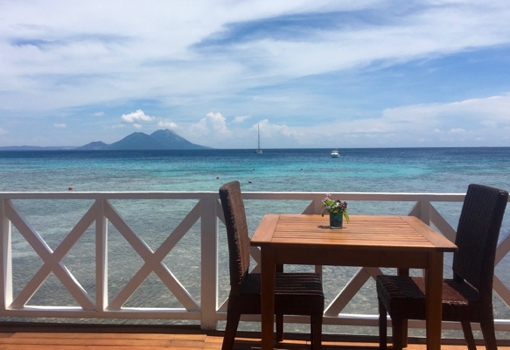 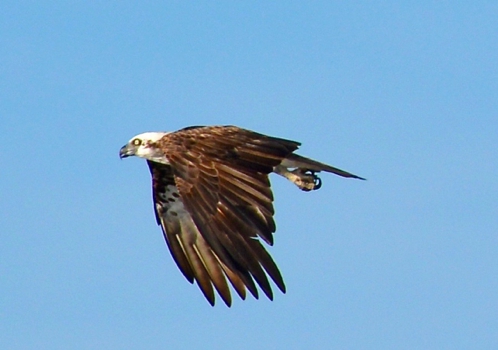 Lochmarin on anchor, seen from the hotel deck, Rapopo dive boat to the right and an Osprey flying by. The hotel arranged for Lucas, so much more than a taxi driver, to take us to immigration and customs. Lucas is a construction engineer, retired now so taxi driving. He has his finger on the pulse, with contacts left right and centre. He comes from a tiny island just North of Manus and, thanks to the Commonwealth, is a graduate from Heriot Watt University, Edinburgh. He returned to PNG to be an academic at the University of Papua New Guinea, lecturing in construction, quantity surveying and project management. We spent a superb couple of days in his company whilst he took us around the town to get boat parts fixed, do our provisioning and just see the sights of the area. 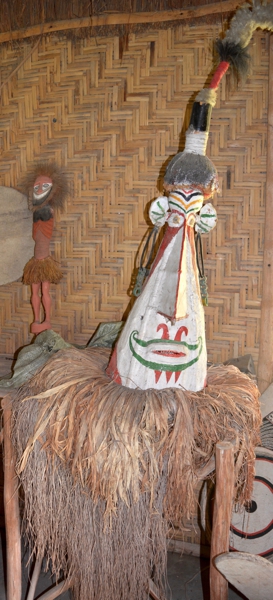   Masks and artefacts in the museum, a surviving hotel in Rabaul (Yumi stap yet means we’re still here!) and one of the many fabulous masks we saw decorating walls. Rabaul, up at the head of Simpson Harbour, was the district capital, a thriving town with a large ex-pat community. It had been taken over by the Japanese during the war then relieved by the Allies. Everywhere you go there are remains to be seen. A Rotary plane engines serves as a centrepiece in the hotel flower bed. The Japanese commander’s bunker is still complete, with maps and Japanese script on the walls. Just off the coast road there is a huge tunnel that POWs scraped out of the cliff face, inside half a dozen tugs still slowly disintegrate. The Japanese used to bring their submarines up to the coast at night, lay rails to the tunnel, drag the tugs and barges down to the sea, unload the goods and clear it all away before daylight could show the Allied planes flying overhead where to bomb. As you drive up to the seismic observatory on the edge of the volcano there are more tunnels carved out of the rock, some to act as look out stations, some to hide men and stores from bombing planes. 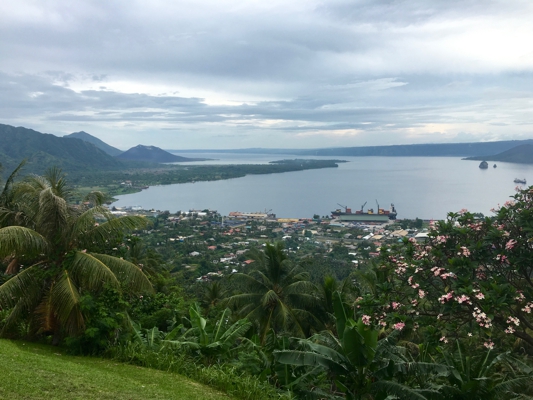 Phil’s view from the seismic observatory, looking out over Simpson Harbour. To the left is where the main part of Rabaul used to be, ahead is the remaining part.  The road workers recovering the coast road, two spades and one digging stick between them. A major problem for folk living up on the mountains is that the thunderstorms wash the soil down the hills. It ends up covering the coast road and they have to dig it out continually. Talking of the volcanoes, those three beautiful giants we look out on across the water are more than just decorative. In 1994 one of them sent out so much ash that it buried the town of Rabaul, up to 15 feet in places. Three quarters of the town was destroyed and, rather than build again where the same thing could happen, the commercial centre moved to Kokopo, which is still growing fast. Back where Rabaul used to be a few houses and businesses hang on but mostly it is simply fields of pumice, with sulphurous hot springs pushing through. So strange to walk down to the beach, see the little waves breaking yet find the water too hot to stand in! 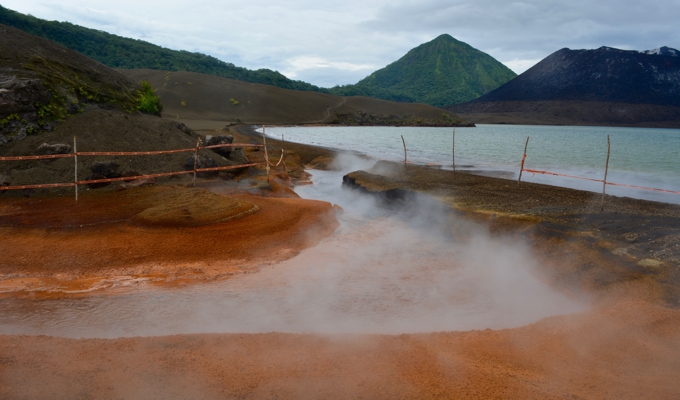  This little chap on the ash fields is a Rainbow Bee-eater. He spends the winter up in PNG and the rest of his time down in Australia. Kokopo was not at all how it had been described to us. We were expecting to have to be escorted in an armoured car through the town to be safe from the Raskols. It feels rather like a Fiji town sprawling and new, bustling with people. One would need to be sensible about not putting phone or wallet in an accessible pocket on a rucksack, and we wouldn’t wander about at night, but apart from that it’s friendly and relaxed. Times have changed here. I would recommend any other cruising boat to come and stay - the Rapopo Plantation Resort will welcome you! (our anchorage location 04 20.021S 152 18.586E)  Looking towards Kokopo from on board. The official name for the islet is mushroom rock. We called him hedgehog rock. *Remember? True and apparent wind? When we were sailing with the wind behind us we didn’t feel the full wind speed because we were travelling with the wind - think of flying in a balloon, it seems all calm up there even though when you look at the ground below you going past you are clearly zooming along - because you are travelling at the same speed as the wind. |